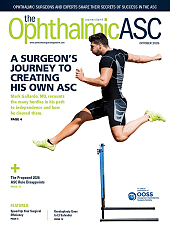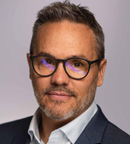From the moment I received my medical degree from the University of Buenos Aires in 1998, I felt a steady and persistent calling toward a life in medicine. That feeling was not simply about acquiring knowledge or achieving a title; it was about answering a deeper responsibility to people whose lives depend on sight.
My formative years at Santa Lucía Hospital in Buenos Aires—Argentina’s largest public eye hospital—made that responsibility concrete. Surrounded by overflowing clinics, limited supplies, and patients who placed their trust in us despite many obstacles, I learned what it truly means to care for others. Those early challenges did not discourage me; they clarified my purpose. I saw firsthand how dedication, creativity, and disciplined inquiry could improve outcomes even when resources were scarce. That conviction has guided my career ever since.
During my university specialist training, anatomy, physiology, diagnostics, and the delicate mechanics of the eye became subjects of fascination and wonder. In my final year, I encountered the Stratus OCT (Zeiss), then a cutting-edge tool that opened a new way of visualizing ocular structures. Its promise for earlier and more precise diagnosis ignited a research interest that led to my first publication in Investigative Ophthalmology and Visual Science.
That paper was modest in scale but monumental for me. It affirmed that careful observation and rigorous inquiry could translate into better care for patients—and it planted the seed for a career that balances clinical practice with research, always driven by the question: How can a new insight or technology be used to help people?

Patricio Schlottmann, MD (second from right) with his team at the Charles Centro Oftalmológico (Charles Research Center) in Buenos Aires. During 2025, the center was involved in more than 10 trials, with more than 160 patients enrolled in ongoing studies.
Broadening Horizons in London
After completing my clinical training at Santa Lucía, I sought broader experience in environments rich in both clinical volume and research intensity. One year later I arrived at Moorfields Eye Hospital in London, an institution defined by excellence and relentless curiosity.
There, I expanded my clinical repertoire across glaucoma, neuro-ophthalmology, and vitreoretinal disease while participating in pioneering research. I helped image one of the earliest patients treated with subretinal gene therapy—an experience that felt like witnessing a new chapter in medicine. I also contributed to work documenting retinal nerve fiber layer loss after optic neuritis, suggesting a measurable biomarker for monitoring multiple sclerosis. Alongside this research, I studied electrophysiology to deepen my understanding of retinal function beyond structural imaging.
At Moorfields I also completed a course in clinical-trial design at the London School of Hygiene and Tropical Medicine, which emphasized the importance of sound methodology, valid endpoints, and ethical integrity. This training taught me that successful research requires both technical expertise and rigorous design, without which promising therapies may never reach patients.
When I returned home, I carried these principles and practices with a clear goal: to adapt them to Argentina’s needs and build a foundation for high-quality ophthalmic research.
Building a Clinical Trials Program in Argentina
After nearly 6 years in London, I returned to Buenos Aires around 2008 with a sense of urgency and possibility. Many patients still lacked access to new therapies, and research infrastructure remained limited. Together with business partners and colleagues who shared my vision, we established a clinical trial site dedicated to ophthalmology.
Building that site demanded patience and teamwork. We recruited and trained staff, invested in modern equipment, implemented Good Clinical Practice standards, and developed strong relationships with ethics committees and the national regulatory agency. Every decision centered on the human element of trials—the patients.

Argentine ophthalmologist Matko Vidosevich, MD, of Grupo Gamma in Rosario, a participant in RIO Latam, enrolled more patients than any other investigator worldwide in a recent diabetic macular edema trial.
Our early achievements were both practical and symbolic: they were the first retina trials conducted in Argentina. We participated in large multicenter trials such as RIDE, RISE, and VIEW 2, recruiting patients efficiently and producing high-quality, timely data. These results demonstrated that Argentina could meet international standards for ophthalmology research.
Over time, our consistent performance helped change perceptions among sponsors and academic partners. We showed that, with trained personnel and robust oversight, Argentina could be an attractive and reliable location for clinical trials.
Argentina’s demographic diversity is one of its greatest assets for clinical research, particularly in retinal diseases such as age-related macular degeneration and diabetic reti
nopathy. The prevalence and variability of these conditions across populations provide valuable data for globally relevant studies.
Access to new medications can be uneven, and structural barriers persist, but the regulatory authority is respected, and clinical-trial capacity continues to expand. I take pride in knowing that the groundwork we laid helped build the momentum that now attracts more studies and collaborations to our country.
Expanding Through Collaboration and Networks
Recognizing that one site alone could not transform Argentina’s research landscape, we focused on building networks. We trained other centers, shared protocols, and helped standardize procedures. We also strengthened relationships with ethics committees and maintained open dialogue with regulators to streamline approvals without compromising safety or quality.
This collaborative approach culminated in the establishment of Red de Investigación en Oftalmología Latinoamérica (RIO Latam, or the Latin American Ophthalmology Research Network), a sustainable regional network for ophthalmology research rooted in best practices, shared training, and ethical rigor. Through RIO Latam, we have standardized data collection, implemented common quality metrics, and offered educational opportunities for investigators and coordinators across Argentina and neighboring countries.
Building a network is as much about mentorship as logistics. Training staff in research conduct—from informed consent to accurate data entry, imaging standards, and adverse-event reporting—has been central to our mission. I have spent countless hours teaching and mentoring colleagues in hospitals large and small. Each well-executed trial, successful audit, and patient whose vision was preserved reaffirms why this work matters. Every trained coordinator, certified technician, and investigator who adopts rigorous methods multiplies our collective impact on patients’ lives.
Representing Argentina at international meetings has also been an important part of our work. I highlight our ethical frameworks, diverse patient population, and skilled human capital ready for complex studies. Promoting Argentina’s capabilities is not merely about attracting trials—it ensures that our patients gain access to cutting-edge therapies and that global innovation aligns with local need.
The path has not been without obstacles, including infrastructure constraints, logistical complexity, and initial skepticism from international sponsors. Each challenge reinforced a key lesson—sustainable progress requires patience, humility, and continuous investment in people and processes. Our long-term strategy remains clear: build competence, demonstrate quality, and scale responsibly.

Dr. Schlottmann with Dr. Anibal Francone (left) and Bindu Manne of Oculis, who was visiting for an ongoing study.
Sustaining Progress and Looking Ahead
Seeing Argentina’s role in ophthalmic clinical research expand has been among the most rewarding aspects of my career. Today there are more trials, more trained professionals, and stronger regional collaboration than when we began. Our network’s reputation for integrity has opened doors for therapies that might otherwise have taken longer to reach our patients.
Looking forward, we will host our National Retina Society meeting in Ushuaia next year—a symbolic and practical opportunity to showcase national achievements, exchange ideas, and inspire younger clinicians to pursue research. Support from biotechnology and pharmaceutical partners will be essential to sustain this growth.
Throughout my journey—from medical school in Buenos Aires to research fellowships at Moorfields, and from patient care to building Argentina’s research capacity—one thread has remained constant: the belief that scientific inquiry and compassionate care are inseparable.
I am grateful to the colleagues, mentors, patients, and regulatory partners who have supported this mission, including international collaborators whose trust has strengthened our work. Our vision remains ambitious yet grounded: to foster a collaborative, innovative, and patient-centered research environment in Argentina and across Latin America. By training, networking, and upholding ethical, high-quality research, we aim to ensure that advances in ophthalmology continue to translate into better lives for people everywhere. RP









